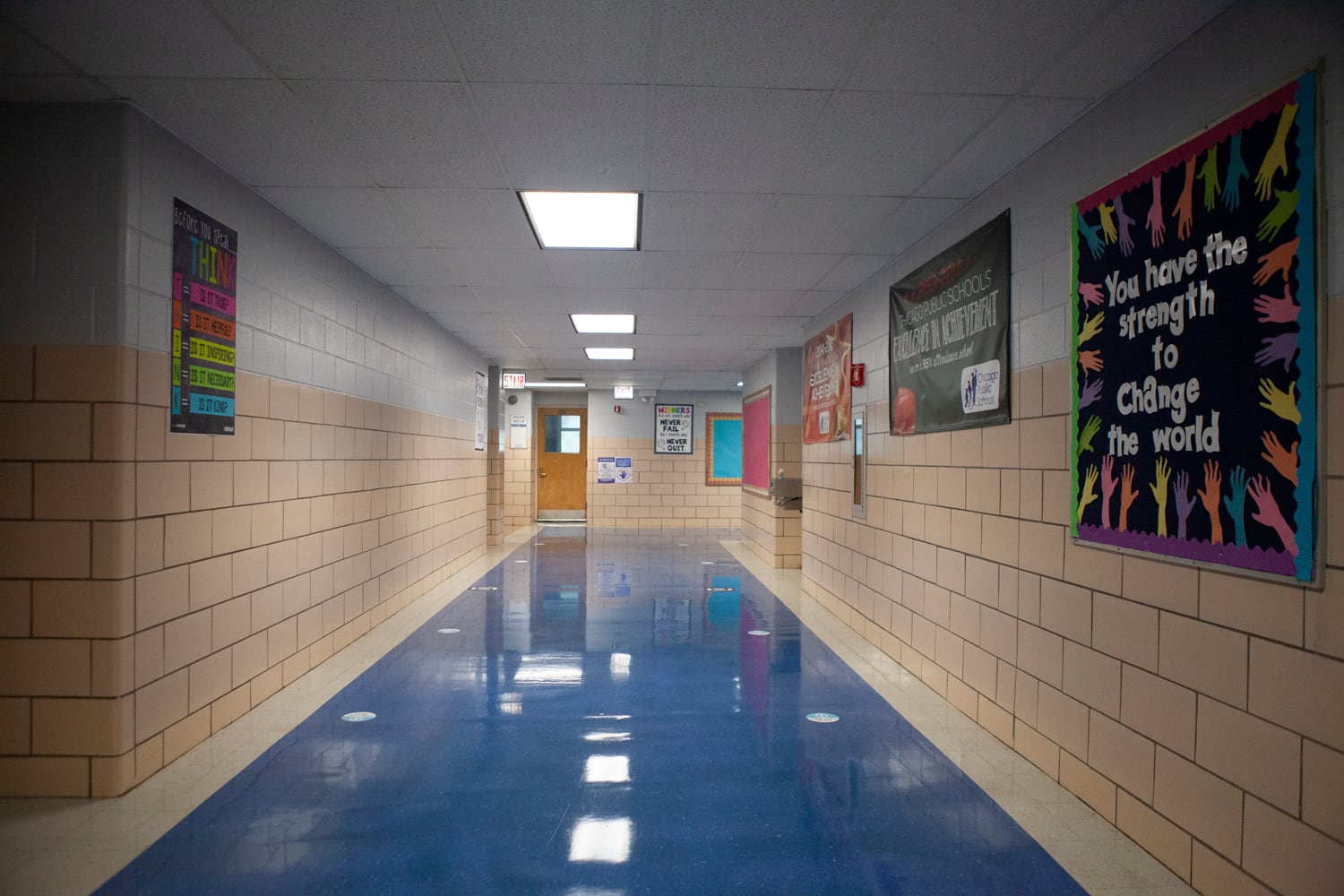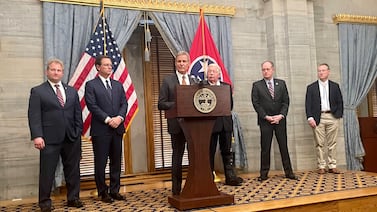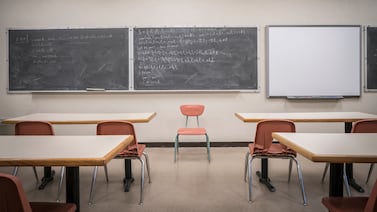Some parents in Chicago’s public schools have to decide by Wednesday whether to send their children back to school buildings later this fall. They’ll do so with little information about cases of coronavirus in schools that opened earlier this year in the city and statewide.
Even though child care centers, some private and charter schools, and the city’s Catholic schools have reopened, the city does not publicly report data in real time about cases connected to those settings.
State and local officials have warned about rising numbers of COVID-19 in recent days — the city’s positivity rate rose to 7.4% — and they have put additional restrictions on bars and restaurants. But they stressed that schools are not behind the increase. Overall, school-age children account for fewer than 1% of cases in the city.
Other than that assurance, parents don’t have much else to go on.
Chicago’s health department said it doesn’t have school and child care data “publicly reportable.” The state health department said it will begin sharing school-level coronavirus data in the coming weeks, but state officials haven’t said how much detail they will include.
The city’s top health official, Dr. Allison Arwady, said Tuesday in a public update on rising case levels that she’s seen an uptick in individual school-based cases, possibly originating in the broader community outside campuses. She didn’t share specific numbers.
So far, national data suggests schools aren’t major sites of virus transmission, particularly in the earlier grades. With more and more schools reopening, outbreaks have been relatively rare. But one key to safely reopening schools is community spread. Children can spread the virus, and in communities with high rates of COVID-19 it can be harder to limit transmission.
In Chicago, some neighborhoods have positivity rates that exceed 20% and are climbing.
Parents of students in pre-kindergarten and some special education programs in Chicago Public Schools have until Wednesday to decide whether they plan to send their children back to school if the district moves forward with a plan to offer in-person instruction for them later this fall.
“It would be incredibly helpful to have more local data,” said Dr. Beth Van Opstal, a Chicago parent and pediatrician. “So many parents are wrestling with this. Are we making the right decisions for our kids? Are we advocating for our communities? This is keeping us up at night.”
Missing school data
As it announced plans to attempt a gradual reopening later this fall, Chicago Public Schools started posting data on COVID-19 cases in its schools, going back to March and broken down by students and employees.
So far since March, the district has reported 220 adult cases and eight student cases at the more than 500 campuses it manages, with an uptick in employee cases this fall as more staff members were summoned back to school buildings. Even though most student learning is happening virtually, the district runs eight sites for supervised remote learning and has hosted some in-person standardized testing for high school students.
As public schools prepare to open, city and district leaders have pointed to the experience of the Archdiocese of Chicago, which reopened hundreds of campuses for full-time in-person instruction in August. The archdiocese has not disclosed publicly the number of COVID-19 cases among students and employees or how often schools have had to quarantine student “clusters,” which are groups of 15 to 23 students who stick together throughout the school day.
But Arwady, the city’s health commissioner, has said students in Catholic schools have about half the rate of the city’s school-age children overall. From mid-August to early this month, school-age children had an infection rate of 0.4%, or 2,147 positive cases, according to the health department. The Archdiocese has not said how many of its more than 40,000 students have returned to school buildings and how many are learning virtually through the city’s Catholic schools.
But Archdiocese officials said earlier this month that the numbers have been highly encouraging, with rigorous contact tracing pointing to only one case of suspected in-school transmission at the time. It’s not clear how these numbers have been affected by the recent rise in coronavirus infections citywide. The health department referred questions about the data to the archdiocese.
What about data for other private schools and some charters that have reopened, which schools across the state are required to report to their local public health departments? Or for childcare centers and in-person park district camps?
“We don’t have publicly reportable data like that at this point but may in the future,” Andrew Buchanan, a spokesman for the city health department, said.
Across Illinois, ProPublica and the Chicago Tribune recently reported COVID-19 outbreaks — meaning two or more related cases — in 44 schools across the state, infecting 105 students and 73 employees. That’s out of more 1,800 public schools and an unknown number of private schools offering some in-person instruction.
Illinois has no public dashboard on school-based cases, unlike many other states. State officials would not identify which schools have had outbreaks and acknowledged they might not have a complete count. They said they would share school-level data soon.
“We have been working to publish school-level data on COVID-19 and look forward to having that live in the coming weeks,” said state health department spokeswoman Melaney Arnold.
She said the data will include school-level numbers of cases and outbreaks though it’s not clear if private campuses will be included as well. Arnold noted that schools are required to let families know when new cases are diagnosed in school communities.
Encouraging numbers, but questions remain
A growing body of national and international data paints an encouraging picture about school reopening — but with important caveats.
The data suggests schools, particularly elementary schools, have not been the sites of significant spread. Some epidemiologists who were previously skeptical about reopening schools have said they have been swayed, especially given the significant academic and health benefits of attending schools in person.
But in some cases, the data is still limited or questionable. For instance, schools that are voluntarily reporting their cases make it difficult to draw definitive conclusions.
“The data show schools can be reopened safely with mitigation strategies in place,” said Dr. Larry Kociolek, a physician at Lurie Children’s Hospital of Chicago and assistant professor of pediatrics at Northwestern University. “There is no clear association between reopening schools and an increase of COVID cases in the community.”
But he stressed these outcomes appear to verge on strong safety measures, including contact tracing, testing, restricting student cohorts throughout the day, and swiftly quarantining groups of students when a classmate or teacher gets sick. And data from other parts of the country do not fully translate to Chicago — especially because a spike in COVID-19 cases can complicate the school transmission picture.
“Every community has its own unique risks based on the level of COVID in that community,” he said. “We certainly need as much data as we can get our hands on to make informed decisions.”
Van Opstal said the archdiocese numbers are reassuring to her as a parent and a physician. But with distinct student demographics and approach to limiting the spread of the virus, the outcomes might not readily translate to public schools, she said. (Archdiocese officials have said that the generally smaller class sizes and the availability of parish spaces that allow students to spread out make comparisons tricky.)
She said she is eager to see more local data, including on child care centers as many parents are still weighing the safety of sending their children there.
“We have national data, but one of the problems is applying those findings to communities that have very high rates of COVID,” she said.
At a Tuesday press conference held by a coalition of parent advocacy groups with backing from the Chicago Teachers Union, parents and teachers said they have many unanswered questions about the district’s safety approach, from the steps the district is taking to ensure proper ventilation to its hiring of additional custodians to its plan for contact tracing and quarantining students and staff.
For some parents, it comes down to the spread of the virus in the broader community, with a second wave of COVID-19 infections chilling interest in sending children back to school buildings.
“I would be more comfortable if I saw numbers go down and stay down,” said parent Sonia Lara. “I would send my child back once it’s safe to do so.”








